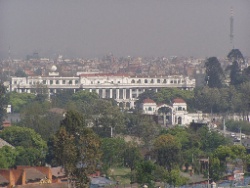Ukraine Recovery And Reconstruction: $486 Billion Over The Next Decade
Reconstruction and recovery in war-torn Ukraine is projected to cost $486 billion over the next decade, up from $411 billion estimated a year ago, a UN-backed study published on Thursday has revealed.
The updated Rapid Damage and Needs Assessment (RDNA3) – issued by Ukraine's Government, alongside the World Bank Group, the European Commission and the UN – covers damage incurred since the start of the full-scale Russian invasion on 24 February 2022 to the end of last December.
The highest needs are in housing, or 17 per cent of the overall estimated costs, followed by transport, commerce and industry, agriculture and energy. Social protection and livelihood support and explosive hazard management are pegged at under 10 per cent, respectively.
Across all sectors, the cost of debris clearance and management, as well as demolition where needed, is almost $11 billion.
Damage and displacement
"Despite the ongoing full-scale war, the Ukrainian Government, with the support of international partners, continues to implement a rapid recovery programme. The execution of the third Rapid Damage and Needs Assessment allows us to approach this process more systematically,” Prime Minister Denys Shmyhal said in a joint press release.
Direct damage in Ukraine has now reached almost $152 billion and is concentrated in the regions of Donetsk, Kharkiv, Luhansk, Zaporizhzhia, Kherson and Kyiv – the same areas that suffered the greatest damage as reported in the previous assessment.
The RDNA3 found that 10 per cent of housing stock across the country – some two million homes – has been damaged or destroyed, prolonging displacement of Ukrainians from their communities.
Furthermore, the destruction of the Kakhovka Dam and the hydropower plant last June has resulted in significant negative impacts on the environment and agriculture while worsening the plight of people already struggling to access housing, water, food and health services.
Russia should pay
The Ukrainian authorities estimate that roughly $15 billion will be needed this year alone for immediate reconstruction and recovery priorities at both national and community levels.
Focus is particularly on supporting and mobilizing the private sector alongside the restoration of housing, soft infrastructure and services, energy and transport. Roughly $5.5 billion has already been secured so far from both Ukraine and international partners.
Prime Minister Shmyhal noted that reconstruction needs have continued to grow over the past year.
“The main resource for Ukraine's recovery should be the confiscation of Russian assets frozen in the West. We need to start this process already this year,” he said.
Inclusive and ‘green’ recovery
The RDNA3 lists critical investment needs for short-term recovery and medium-term reconstruction. Where possible, it considers and excludes needs that have already been met through the state budget and support provided by partners and the international community.
The assessment also highlights the continued need for reforms and policies that catalyze private sector involvement and ensure an inclusive and “green” recovery. It also provides stronger data analysis of the impact on both vulnerable people and communities.
Invest in Ukraine’s people
Denise Brown, the UN Resident and Humanitarian Coordinator in Ukraine, underscored the need to invest in the Ukrainian people because the future of the country depends on them.
“The war is not over; the suffering is not over,” she said. “But, communities in Ukraine are demonstrating significant courage and commitment in driving their own inclusive recovery processes, and they need the continued support of their international partners.”
The findings in the RDNA3 complement the Government’s Ukraine Plan and the European Union (EU) Ukraine Facility, both of which are forthcoming. These instruments lay out a reform and investment agenda for the next four years as Ukraine prepares to join the EU.
Prime Minister Shmyhal said the Government “is creating conditions to attract private investments, which will accelerate the reconstruction process and transform our country on its path to the EU".
Since the last assessment in March 2023, the authorities, supported by partners, have met some of the most urgent needs, such as disbursing $1 billion for housing sector recovery and carrying out more than 2,000 kilometres of emergency repairs on motorways, highways and other national roads.
Culture under attack
The war has also taken a toll on Ukraine’s culture and tourism sectors. Damage is estimated at nearly $3.5 billion, up from $2.6 billion last year – a 40 per cent increase.
Nearly $9 billion will be needed for recovery over the next decade, the UN Educational, Scientific and Cultural Organization (UNESCO) said this week.
A total of 4,779 cultural and tourist assets in Ukraine have been reported as damaged, including buildings of heritage value, works of art, workshops for creative industries and tourism facilities.
The Kharkiv region was the worst affected, accounting for one quarter of the damage, followed by Donetsk and Odessa.


 NZ Harkness Fellowship Trust: Championing Innovation In Māori Economic Development - Jacob (Hākopa) Ashdown Named 2025 Harkness Fellow
NZ Harkness Fellowship Trust: Championing Innovation In Māori Economic Development - Jacob (Hākopa) Ashdown Named 2025 Harkness Fellow ICHRP: Trump 20% Tariff On Philippine Exports Hits Workers, Farmers Hardest
ICHRP: Trump 20% Tariff On Philippine Exports Hits Workers, Farmers Hardest New Zealand Defence Force: HMNZS Canterbury Delivers Leading-Edge Technology To Support Regional Security Tasks In Fiji
New Zealand Defence Force: HMNZS Canterbury Delivers Leading-Edge Technology To Support Regional Security Tasks In Fiji Asia New Zealand Foundation: ASEAN Young Business Leaders To Meet In Viet Nam, Marking 50 Years Of ASEAN-New Zealand Relations
Asia New Zealand Foundation: ASEAN Young Business Leaders To Meet In Viet Nam, Marking 50 Years Of ASEAN-New Zealand Relations Asian Human Rights Commission: Nepal | Joint Submission To The UN Universal Periodic Review - 51st Session Of The UPR Working Group
Asian Human Rights Commission: Nepal | Joint Submission To The UN Universal Periodic Review - 51st Session Of The UPR Working Group Caleb Fotheringham, RNZ Pacific: Cook Islands' 60th Anniversary - 'Who New Zealand Sends, Sends A Message'
Caleb Fotheringham, RNZ Pacific: Cook Islands' 60th Anniversary - 'Who New Zealand Sends, Sends A Message'